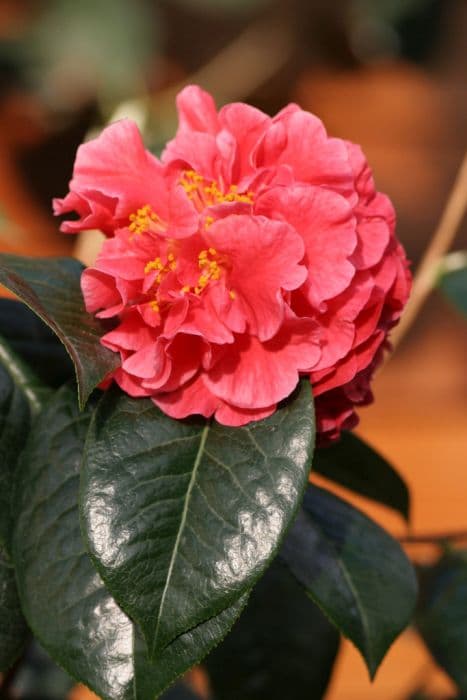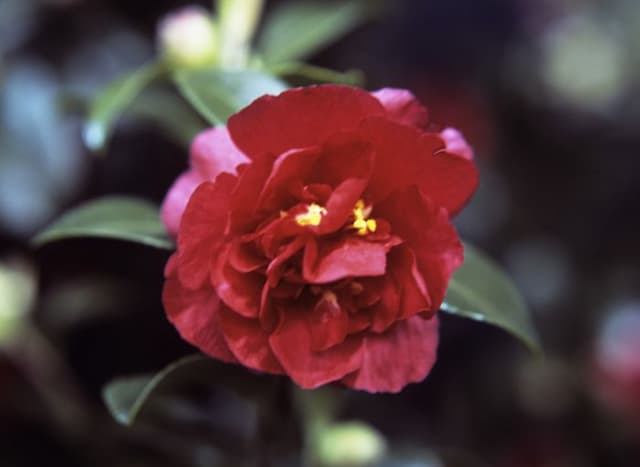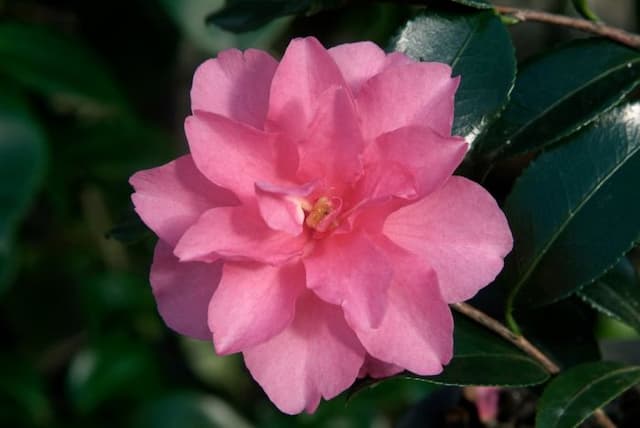Williamsii Camellia Camellia × williamsii 'William Carlyon'

ABOUT
The Camellia × williamsii 'William Carlyon' is an ornamental plant known for its beautiful, showy flowers and glossy, dark green foliage. The leaves are oval-shaped with a slightly serrated edge, providing a lustrous backdrop to its blooms. The flowers stand out in the garden, featuring delicate petals that are usually arranged in a formal, symmetrical pattern around the central stamens. They exhibit a soft pink hue that can vary in intensity, sometimes appearing almost white with shades of pink. The petals may have a slightly ruffled or smooth texture, contributing to the plant's overall elegance and charm. This variety is admired for its long blooming period, gracing gardens with its colorful display and potentially attracting pollinators such as bees and butterflies.
About this plant
 Names
NamesFamily
Theaceae.
Synonyms
Williams' Camellia, Hybrid Camellia.
Common names
Camellia × williamsii 'William Carlyon'.
 Toxicity
ToxicityTo humans
Camellia typically poses no significant toxicity risk to humans. However, caution should be exercised as some people might have individual allergies or sensitivities to plants. If any part of the camellia plant is ingested, the most common effects could include mild gastrointestinal upset such as nausea or diarrhea. It is generally not considered highly toxic, but it is advisable to keep all non-food plants out of reach of small children who might accidentally ingest plant material.
To pets
Camellia is generally considered non-toxic to pets. However, as with any plant, individual animals may have sensitivities or allergic reactions. The ingestion of camellia leaves or flowers by pets may lead to mild gastrointestinal upset, including vomiting or diarrhea, though serious toxicity is unlikely. It is always wise to prevent pets from consuming non-food plants, as they may cause digestive discomfort or other issues.
 Characteristics
CharacteristicsLife cycle
Perennials
Foliage type
Evergreen
Color of leaves
Green
Flower color
Pink
Height
6-10 feet (1.8-3.0 meters)
Spread
5-8 feet (1.5-2.4 meters)
Plant type
Shrub
Hardiness zones
7
Native area
Asia
Benefits
 General Benefits
General Benefits- Ornamental Value: Camellia × williamsii 'William Carlyon' offers aesthetic appeal with its beautiful pink flowers, adding a pop of color to gardens.
- Long Blooming Period: It usually has a long flowering season from late winter to spring, providing a consistent display of blooms when few other plants are in flower.
- Drought Resistance: Once established, it is relatively drought-tolerant, reducing the need for frequent watering.
- Shade Tolerance: This plant can grow well in partial shade, making it a versatile choice for different garden aspects.
- Cold Tolerance: It has a degree of cold tolerance, allowing it to thrive in areas with cooler winter temperatures.
- Evergreen Foliage: The plant provides year-round interest with its glossy, evergreen leaves, contributing to the garden’s structural design.
- Wildlife Attraction: The flowers may attract pollinators like bees, thus supporting local ecosystems.
- Low Maintenance: It is generally low maintenance, requiring little pruning and care once established.
- Privacy Screen: Due to its dense growth habit, it can be used as a privacy screen or hedge in gardens.
 Medical Properties
Medical PropertiesThis plant is not used for medical purposes.
 Air-purifying Qualities
Air-purifying QualitiesThis plant is not specifically known for air purifying qualities.
 Other Uses
Other Uses- Flower Arrangements: The flowers of Camellia × williamsii 'William Carlyon' can be cut and used in flower arrangements due to their large, colorful blooms that add elegance to any bouquet.
- Wedding Decor: With its attractive flowers, the camellia can be incorporated into wedding decor, particularly in the creation of bridal bouquets or as part of the floral displays.
- Photography Subject: Enthusiasts and professional photographers often use the camellia's stunning blooms as the subject of artistic photographs, capturing the plant in various stages of bloom.
- Art Inspiration: Artists may use the beauty of the camellia flowers as an inspiration for paintings, drawings, or fabric designs, celebrating its delicate shapes and colors.
- Culinary Garnish: Although not commonly consumed, the petals of Camellia × williamsii 'William Carlyon' can sometimes be used as a non-toxic garnish to decorate plates and dishes in high-end culinary presentations.
- Dye Production: The petals of the camellia can be used to extract natural dyes for fabric, although this use is not as widespread as with other plants.
- Botanical Studies: Being a hybrid, Camellia × williamsii 'William Carlyon' serves as an interesting subject of study for botanists and horticulturists interested in plant genetics and hybridization processes.
- Educational Tool: Schools and universities may use this plant in educational programs to teach about plant biology, hybridization, and the importance of plant diversity.
- Symbolic Gift: Camellias are often given as gifts symbolizing love, affection, or admiration, making Camellia × williamsii 'William Carlyon' a thoughtful present for special occasions.
- Traditional Crafts: In some cultures, the blossoms or leaves of camellias can be used in the creation of traditional crafts, such as pressed flower art or the decoration of handmade paper.
Interesting Facts
 Feng Shui
Feng ShuiThe Camellia is not used in Feng Shui practice.
 Zodiac Sign Compitability
Zodiac Sign CompitabilityThe Camellia is not used in astrology practice.
 Plant Symbolism
Plant Symbolism- Adoration: Camellia × williamsii 'William Carlyon', commonly known as simply Williamsii, symbolizes adoration due to its perfect and delicate petals, which reflect the admiration one might have for another.
- Devotion: The Williamsii has been a symbol of devotion, with its evergreen nature representing the steadfastness of loyal love.
- Perfection: With its immaculate form, Williamsii is often associated with perfection, hinting at the ideal state or condition.
- Longevity: As a plant that can thrive for many years, Williamsii symbolizes longevity and the wish for a long and healthy life.
- Refinement: The delicate beauty and subtle fragrance of the Williamsii are emblematic of refinement and tasteful elegance.
 Water
WaterThe Williamsii camellia should be watered thoroughly to ensure the root zone is moist, particularly during dry periods. For established plants, once a week is generally sufficient. If the weather is particularly hot or windy, check the soil moisture more frequently, as you may need to water twice a week. When watering, avoid wetting the leaves to prevent fungal diseases. Apply about 1 to 1.5 gallons of water for each watering session to properly hydrate the soil around the plant.
 Light
LightWilliamsii camellias prefer bright, indirect light or part shade. They thrive under the dappled shade of larger trees or on the north or east side of a building. Direct afternoon sunlight should be avoided as it can scorch the leaves and lead to stress for the plant. A spot with morning sun and afternoon shade is ideal for optimal growth and flower production.
 Temperature
TemperatureWilliamsii camellias are hardy and can tolerate temperatures down to about 10 degrees Fahrenheit but prefer a range between 40 and 70 degrees Fahrenheit for optimal growth. Extreme heat above 90 degrees Fahrenheit can be detrimental, especially if combined with direct sunlight. Ideal growing conditions include a consistently cool to moderate environment.
 Pruning
PruningPrune Williamsii camellias to maintain shape and remove any dead or weak branches. Light pruning is best done immediately after flowering in the spring to ensure bud set for the next season. Pruning can also stimulate new growth and help in controlling the size of the plant. Avoid heavy pruning as this can reduce flowering.
 Cleaning
CleaningAs needed
 Soil
SoilWilliams' Camellia prefers acidic soil with a pH range of 5.5 to 6.5. A good soil mix contains equal parts of peat moss, pine bark, and perlite or coarse sand to ensure good drainage and aeration, which is vital for healthy root growth.
 Repotting
RepottingWilliams' Camellia should be repotted every two to three years, preferably in the spring after flowering. Younger plants may need more frequent repotting, while older, more established plants can be repotted less often.
 Humidity & Misting
Humidity & MistingWilliams' Camellia thrives at a moderate to high humidity level, ideally between 50-60%. To maintain optimal humidity, the plant may benefit from a humidifier or pebble tray with water in a dry indoor environment.
 Suitable locations
Suitable locationsIndoor
Place Williams' Camellia in bright, indirect light inside; avoid dry heat sources.
Outdoor
Plant Williams' Camellia in partial shade; shelter from strong winds and frost.
Hardiness zone
7-9 USDA
 Life cycle
Life cycleCamellia × williamsii 'William Carlyon', commonly known as Williamsii camellia, begins its life cycle with seed germination, typically in spring, where the plant emerges from the soil as a seedling. It grows into a juvenile plant through the vegetative stage, developing a sturdy stem and dark green, glossy leaves. As it matures, the Williamsii camellia enters the flowering stage—usually starting from late winter to early spring—where it produces showy flowers that can range from white to pink and occasionally have streaks of deeper color. After pollination, which is often aided by bees, the flowers develop into seed pods. Once the seeds mature, the pods open to release them, completing the reproductive cycle. The plant continues to grow and can live many years, going through repeated cycles of growth and reproduction, entering a period of dormancy during colder months until the next flowering season.
 Propogation
PropogationPropogation time
Spring-Early Summer
The most popular method of propagating Camellia × williamsii 'William Carlyon', commonly known as Camellia, is through semi-hardwood cuttings. This is typically done in late summer when the current year’s growth has started to mature. A healthy, non-flowering stem is selected, and a cutting of about 4 to 6 inches (10 to 15 centimeters) is taken. The lower leaves are removed, and the cut end can be dipped in a rooting hormone to encourage root development. The cutting is then placed in a potting mix that is well-draining, such as a mixture of peat and perlite or sand. The pot is kept under partially shaded conditions and the soil is maintained moist but not soggy. Rooting usually takes several months, after which the young camellia can be transplanted to a more permanent location.









